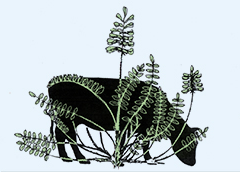Abstract
Fungal endophyte-infected forages have been shown to alter herbivore feeding preferences. The objective of this experiment was to compare the preference of cattle, sheep, and goats for plants containing (E+) and not containing (E-) fungal endophytes using freshly harvested Oxytropis sericea, Ipomoea carnea, and Ipomoea asarifolia. Goats and sheep rejected all forage choices regardless of endophyte status except for grass and alfalfa hay. Endophyte status had no influence on cattle forage preferences. Cattle rejected all Oxytropis sericea E+ and E- choices. Cattle discriminated between Ipomoea species, preferring Ipomoea carnea to Ipomoea asarifolia (P = 0.004). In all comparisons, Ipomoea carnea was selected over Ipomoea asarifolia. Cattle did not discriminate between E+ and E- plants of either species (P > 0.33). Cattle preferred E+ Ipomoea carnea over E- Ipomoea asarifolia (P = 0.03), E- Ipomoea carnea over E- Ipomoea asarifolia (P = 0.003), E- Ipomoea carnea over E+ Ipomoea asarifolia (P = 0.001), and E+ Ipomoea carnea over E+ Ipomoea asarifolia (P = 0.01). Nutritional composition, including nonstructural carbohydrate concentrations, did not explain cattle preferences, as Ipomoea asarifolia contained higher total carbohydrate concentrations than did Ipomoea carnea. The presence of ergot and indole diterpene alkaloids in E+ Ipomoea asarifolia, or swainsonine in E+ Oxytropis sericea and E+ Ipomoea carnea did not influence cattle preference because cattle did not discriminate between E- and E+ plants. This study suggests that for these specific toxic plants, endophyte status plays no part in preferences of grazing cattle. For grazing animals, selection by livestock is related to forage scarcity or low nutrient content in the other available forage.
Recommended Citation
Pfister, James; Cook, Daniel; Lee, Stephen T.; Gardner, Dale R.; and Riet-Correa, Franklin
(2020)
"Livestock preference for endophyte-infected or endophyte-free Oxytropis sericea, Ipomoea carnea, and Ipomoea asarifolia,"
Poisonous Plant Research (PPR): Vol. 3, p. 58-73.
DOI: https://doi.org/10.26077/8h4g-v983
Available at:
https://digitalcommons.usu.edu/poisonousplantresearch/vol3/iss1/5
Included in
Beef Science Commons, Pharmacology, Toxicology and Environmental Health Commons, Sheep and Goat Science Commons

